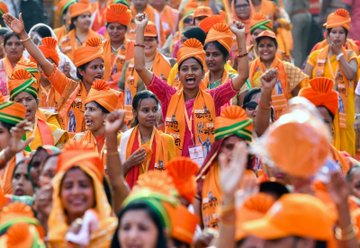Prime Minister Narendra Modi, in his bid for a third consecutive term from the BJP stronghold, filed his nomination for the 2024 Lok Sabha election from Varanasi, Uttar Pradesh. Accompanied by a lineup of senior leaders from the Bharatiya Janata Party and its allies, including JP Nadda, Amit Shah, Rajnath Singh, Eknath Shinde, and Conrad Sangma, Modi embarked on a flashy six-kilometer roadshow the previous evening.
This morning, on his way to submit his papers, Modi offered prayers at Varanasi’s renowned Dashashwamedh Ghat, flanked by UP Chief Minister Yogi Adityanath, and visited the Kaal Bhairav Temple. Expressing his sentiments before visiting the temple, Modi remarked, “My bond with Kashi is profound, indissoluble, and beyond words!”
“I am profoundly moved and overwhelmed! I cannot fathom how swiftly a decade has slipped by under the affectionate embrace of this city. Today, Mother Ganges has embraced me,” Modi remarked emotionally after filing his nomination.
Following the nomination filing, the Prime Minister is anticipated to address his supporters.
Reflecting on Monday’s roadshow, Modi expressed, “The love and blessings bestowed upon me by the residents of Kashi during the roadshow have left an indelible mark on my heart.” Seeking a third consecutive term from the BJP stronghold, Modi aims to maintain the party’s dominance, having secured victory in Varanasi eight times since 1991, with only RK Mishra of the Congress managing to disrupt the streak in 2004. Varanasi is scheduled to vote in the seventh and final phase of the election on June 1. In the 2019 polls, Modi secured a victory margin of nearly 4.8 lakh votes, a significant increase from his 3.72 lakh winning margin five years earlier.
In the 2014 election, Varanasi witnessed a high-profile contest between Modi and Aam Aadmi Party leader Arvind Kejriwal, who garnered just over 20 percent of the votes in his BJP fortress debut. This time, Modi’s primary contender on paper is Congress’ Ajay Rai, who garnered 1.52 lakh votes in 2019 with an improved vote share of 7.04 percent.
Varanasi’s demographic composition comprises approximately 75 percent Hindus and 20 percent Muslims. Scheduled Tribes account for an estimated 10 percent of the population, while Scheduled Castes make up only 0.7 percent. The rural-urban divide stands at 65 to 35 percent.




